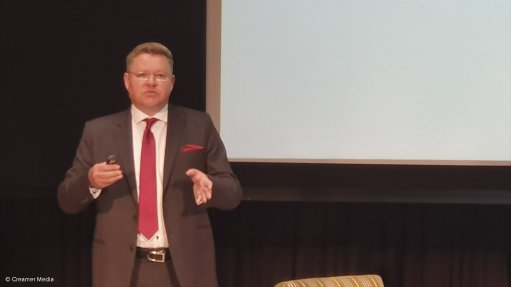
IGUA-SA executive officer Jaco Human
The Industrial Gas Users Association of Southern Africa (IGUA-SA) warned on Wednesday that South Africa is in the midst of a gas supply crunch, which will worsen dramatically from 2025 onwards in line with depleting production from Sasol’s Pande and Temane gasfields, in southern Mozambique.
The association includes large industrial companies that collectively consume 50-million gigajoules of gas yearly, employ 46 000 people and have combined yearly revenues of R150-billion. It is forecasting a yearly shortfall of 98-million gigajoules from 2025 onwards, including Sasol gas demand.
Speaking at an energy event organised by Nedbank and EE Publishers, IGUA-SA executive officer Jaco Human said that the pace of the decline might be delayed by a few years as a result of proposed investments by Sasol in Mozambique. Nevertheless, additional sources would still be required not only to replace dwindling Mozambican supply, but also to meet any new industrial demand.
Prospects for meeting demand from domestic and regional sources were unrealistic in the short term, he said, despite world-class discoveries in the Rovuma basin, of northern Mozambique, and promising exploration off South Africa’s south coast, which resulted in the so-called Brulpadda discovery. Therefore, Human argued that South Africa should accelerate plans for the importation of liquefied natural gas (LNG).
He also stressed that Richards Bay, in KwaZulu-Natal, and Maputo, in Mozambique, were the only two realistic locations for the construction of LNG import infrastructure within the time that remained for closing the demand-supply gap.
State-owned logistics group Transnet has, together with the International Finance Corporation, initiated a feasibility study into the development, by 2024, of an LNG storage and regasification terminal at the Port of Richards Bay. However, the Department of Mineral Resources and Energy has indicated its preference for the building of the terminal in the Coega Industrial Development Zone at the Port of Ngqura, in the Eastern Cape.
“Coega would be of no consequence to the current user base,” Human said, noting that most industrial gas users were located in Gauteng or KwaZulu-Natal, owing to the fact that South Africa’s current gas infrastructure was located on the eastern side of the country.
Alternatively, industry could tap into the private LNG terminals being proposed for Maputo, which would require a link of only 89 km into the existing Rompco pipeline.
Human lamented the lack of policy certainty in the gas sector, as well as the absence of any concrete plans for meeting South Africa’s gas energy challenge in the timeframe outlined. “We are out of time whilst the stakes are high – the [domestic] gas situation is moving on to corporate risk registers locally and globally.”
To address the current insecurity of supply IGUA-SA is calling for the urgent creation of a public-private structure through which industry and government can collaborate on solutions.
“The South African economy requires the State to be the catalyst rather than the controller of the development of the gas economy.”
The organisation also believes that the creation of a demand aggregator should be considered so as to create the economies of scale required to stimulate investment in LNG import and logistics infrastructure.